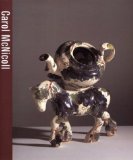

 |

|

The average rating for Carol McNicoll based on 2 reviews is 4 stars.
Review # 1 was written on 2016-11-07 00:00:00 Kathi Eason Kathi EasonTruly the most compulsively interesting and readable book on old silver I've yet read. Arthur Hayden has much of interest to say about "The Marks Stamped on Silver". He selects a series of choice pieces of English, Scottish and Irish silverware, and illuminatingly describes each not just by its hallmarks (beautifully reproduced), but also by vividly conjuring up the exact period of history in which each precious article under discussion was made and used. Since the reign of King Edward I (1272 - 1307), both objects and coinage of the Realm had been produced from gold and silver. Assay and hall-marking of objects made from precious metals guaranteed value. Hayden explains the British system of assaying and (hall)marking functional items made from silver and gold. Clipping gold and silver plated coins was common practice, as was coining false (counterfeit) money. Both hammered and milled coins were legal tender concurrently until the reign of Charles II (1625 - 1649). Hammered coins varied in weight and could be clipped; fortunes were made. This is so very much more than 'just' a book on old silver. Hayden draws his reader in, extending an invitation to imagine their eighteenth century candlesticks, inherited down the line from their great-grandfather …. wax candles illuminating the tense game currently in play at the card table, one dark night in 1750. Thoughts turn to the soft reflections of candlelight off silver. How very different a world without electric lighting must have been from our own. Further on, discussing a Commonwealth porringer assayed in the year 1653, he muses, "it is futile to conjecture with exactitude for what purpose this vessel was used, it belongs to the year when the Dutch were defeated off Portland in February, again off the North Foreland in June, and off Texel in July, when Van Tromp was killed. In the year of this porringer Oliver Cromwell forcibly dissolved the Rump Parliament." Hayden uses a George III cream-jug to demonstrate the practice of taking tea in the eighteenth century "it was etiquette to place the spoon in the cup to show the hostess that no more tea was required. . . . The guests did not ask for a second cup until all the other guests had finished the first (a rule which might well be acted upon to-day)". How curious that in the early twenty-first century we should be so obsessed with fictional twentieth century wealth (Brideshead Revisited and, dare I mention, 'Downton Abbey'); yet be largely blissfully ignorant of the social codes of the elite of the eighteenth century! Arthur Hayden died in 1946; but not before his name had become inextricably linked, notwithstanding his death, to the title of his book. Later editions maintained his 'authorship'. The 1915 edition of this book is out of copyright, and is available online at the Internet Archive to download at |
Review # 2 was written on 2015-01-20 00:00:00 Wathab Haj Wathab HajI was compelled to read this short book after a very moving trip to the British Museum. I'd spent most of the day looking at Roman perfume bottles, and I was walking briskly through the main Roman gallery en route to Minoan Crete when the cup came into my vision. I recalled reading about it, and despite having been to the museum many times I'd never knowingly looked at it. I thought that on this occasion I ought to. So, wedged between East Asian tourists, I had my religious experience with the piece. The book does well to express my feelings about it. It's a very sensual piece, and open to a very satisfying amount of debate as to its meaning. I find it incredible how well crafted the cup is; the images are amazingly clear and modern looking compared to similar works from the period displayed in the book. The cup's modern history is intriguing too; the controversial figure of Edward Perry Warren deserves further reading I think. Anyway, the book does a good job of bringing together a selection of topics to do with the cup, including a detailed description of what is depicted and the physical condition of the cup. Really the price of the book is worth it just for the great photographs. Fascinating and beautiful. |
CAN'T FIND WHAT YOU'RE LOOKING FOR? CLICK HERE!!!